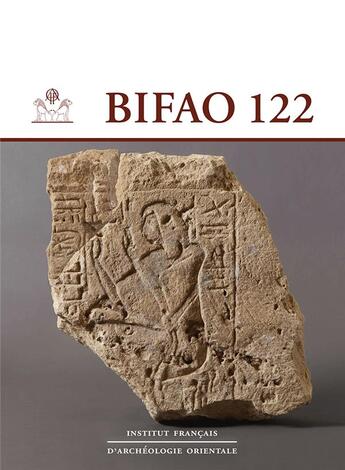Résumé:
Le Bulletin de l'Institut français d'archéologie orientale (BIFAO) couvre l'ensemble des champs de l'égyptologie depuis sa première publication en 1901. Les études qui y paraissent, dont l'aire chronologique s'étend de l'Égypte prédynastique jusqu'à l'époque byzantine, illustrent l'état des... Voir plus
Le Bulletin de l'Institut français d'archéologie orientale (BIFAO) couvre l'ensemble des champs de l'égyptologie depuis sa première publication en 1901. Les études qui y paraissent, dont l'aire chronologique s'étend de l'Égypte prédynastique jusqu'à l'époque byzantine, illustrent l'état des recherches actuelles dans les domaines de l'archéologie, l'épigraphie, la lexicographie, l'iconographie, la religion et la philologie.
Parmi les 16 contributions que regroupe le BIFAO 122, on signalera le rapport préliminaire des fouilles conduites à Tell el-Samara par une équipe conjointe de l'Ifao et du Ministère égyptien du Tourisme et des Antiquités, qui ont permis de dégager, à l'est du Delta, les vestiges d'un des plus anciens villages égyptiens connus à ce jour ; une étude sur la découverte, en 2019, de blocs de pierre au nom de Ramsès II dans la maçonnerie d'un bâtiment au centre du kôm de Plinthine, qui attestent de l'implication ramesside dans la frange septentrionale de la Maréotide, que l'on pensait jusqu'ici dépourvue d'occupation avant l'époque ptolémaïque ; un réexemen des données chronologiques du règne de Snéfrou à l'aune, notamment, d'archives photographiques inédites ; la présentation d'une collection de scellés et d'empreintes de sceaux à noms royaux de la VIe dynastie, retrouvés à Balat dans le secteur sud du palais des gouverneurs ; deux études sur les masques funéraires d'époque romaine, avec présentation, pour l'une d'entre elles, d'un nouveau portrait, unique et complet, et de plusieurs fragments retrouvés à Philadelphie. Les fouilles de la mission espagnole à Dra Abou el-Naga sont mises à l'honneur à travers deux études, dont l'une porte sur une série de pièces complètes en chanvre, qui fournissent l'occasion d'envisager avec précision les particularités de l'utilisation du chanvre, les caractéristiques techniques propres à sa fabrication et les parallèles connus. On notera encore la publication du P. Vatican 38566, écrit par au moins deux scribes, qui met en lumière une tradition méconnue du Livre des Morts durant la Troisième Période intermédiaire, ou celle d'une stèle insolite d'époque gréco-romaine, sans doute de provenance thébaine, appartenant à un certain Pachermontou-panakht, dont la divinisation post-mortem a conduit à son assimilation à Montou-Rê.
The Bulletin of the French Institute of Oriental Archaeology (BIFAO) has covered the entire field of Egyptology since its first appearance in 1901. Studies published in the BIFAO have a chronological spread from prehistory to the Byzantine period, illustrating the present state of research in the disciplines of archaeology, epigraphy, lexicography, iconography and philology.
Among the 16 contributions that make up BIFAO 122 are the preliminary report of archaeological excavations carried out at Tell el-Samara in the eastern Nile Delta by a joint IFAO and Egyptian Ministry of Tourism and Antiquities mission, which unearthed the remains of one of the most ancient villages known so far in Egypt; the study of some stone blocks bearing the name of Ramesses II discovered in 2019 in the masonry of a building in the center of the mound at Plinthine (Kom el-Nugus), which show Ramesside involvement in the western part of the Delta, particularly at the northern edge of Mareotes, although it was long thought to be devoid of occupation before the Ptolemaic period; a reassessment of chronological data from Snefru's reign on the basis, among other sources, of some unpublished photographic archives; the presentation of a set of sealings and of impressions of royal seals from the Sixth Dynasty recovered in the southern part of the governors' palace at Balat; two studies on funerary masks from the Roman period, one presenting a new complete and unique portrait, and some fragments uncovered in the necropolis of ancient Philadelphia. The excavations of the Spanish mission at Dra Abu el-Naga are highlighted through two studies, one of which concerns a series of complete hemp pieces, which provide an opportunity to consider in detail the particularities of the use of hemp, the technical characteristics of its manufacture, and the known parallels. One should also note the publication of P. Vatican 38566, written by at least two scribes, which sheds light on a little-known tradition of the Book of the Dead during the Third Intermediate Period; and of that of an unusual stele from the Greco-Roman period, most probably of Theban origin, belonging to a certain Pashermontu-panakht, whose post-mortem divinization led to his being assimilated to Montu-Ra.















